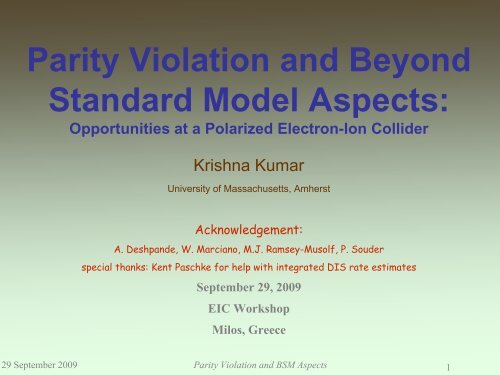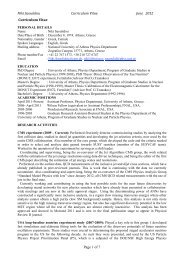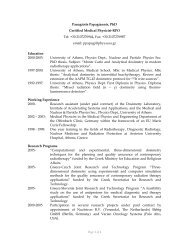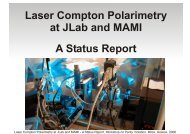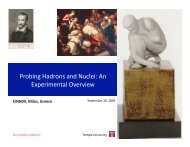Parity Violation and BSM Aspects
Parity Violation and BSM Aspects
Parity Violation and BSM Aspects
Create successful ePaper yourself
Turn your PDF publications into a flip-book with our unique Google optimized e-Paper software.
<strong>Parity</strong> <strong>Violation</strong> <strong>and</strong> Beyond<br />
St<strong>and</strong>ard Model <strong>Aspects</strong>:<br />
Opportunities at a Polarized Electron-Ion Collider<br />
Krishna Kumar<br />
University of Massachusetts, Amherst<br />
Acknowledgement:<br />
A. Deshp<strong>and</strong>e, W. Marciano, M.J. Ramsey-Musolf, P. Souder<br />
special thanks: Kent Paschke for help with integrated DIS rate estimates<br />
September 29, 2009<br />
EIC Workshop<br />
Milos, Greece<br />
29 September 2009 <strong>Parity</strong> <strong>Violation</strong> <strong>and</strong> <strong>BSM</strong> <strong>Aspects</strong><br />
1
Preface<br />
• Any new machine that pushes the intensity frontier is of interest<br />
to the precision EW community<br />
• The EIC, especially with potentially high luminosity projections,<br />
is no exception<br />
• We have just launched a study with the motivation to explore<br />
potentially interesting <strong>and</strong> unique EW physics with the projected<br />
EIC machine parameters<br />
– What SHOULD be the parameters of the collider be<br />
to make it uniquely interesting for precision EW tests<br />
<strong>and</strong> searches for physics beyond the st<strong>and</strong>ard model?<br />
– What are the detector capabilities <strong>and</strong> resources<br />
required to achieve the required sensitivity <strong>and</strong><br />
precision?<br />
In this talk, we describe the motivation; the questions above would be<br />
addressed in a dedicated study if there is enough interest/quorum<br />
29 September 2009 <strong>Parity</strong> <strong>Violation</strong> <strong>and</strong> <strong>BSM</strong> <strong>Aspects</strong><br />
2
Outline<br />
• Weak Neutral Current Interactions<br />
– indirect effects of new TeV-scale dynamics<br />
• <strong>Parity</strong> Violating deep inelastic scattering (PVDIS)<br />
– The Developing Jefferson Lab 12 GeV PV Program<br />
• Electroweak Physics at the EIC<br />
– Advantages over fixed target<br />
– New PV observables<br />
– Two specific applications to nucleon structure<br />
• quark helicity distributions<br />
• Isovector EMC effect<br />
• Lepton Flavor <strong>and</strong> Number <strong>Violation</strong><br />
– electron-tau lepton conversion<br />
• Conclusions & Outlook<br />
29 September 2009 <strong>Parity</strong> <strong>Violation</strong> <strong>and</strong> <strong>BSM</strong> <strong>Aspects</strong><br />
3
Worldwide Experimental Thrust in<br />
the 2010s: New Physics Searches<br />
Compelling arguments for “New Dynamics” at the TeV Scale<br />
A comprehensive search for clues requires:<br />
Large Hadron Collider<br />
Low Q 2 experiments address four broad topics; complement the LHC:<br />
• Neutrino mass <strong>and</strong> mixing 0⎨®® decay, ⎝ 13 , ® decay, long baseline neutrino expts<br />
• Rare or Forbidden Processes EDMs, charged LFV, 0⎨®® decay<br />
• Dark Matter Searches<br />
as well as<br />
• Low Energy Precision Electroweak Measurements:<br />
Lower Energy: Q 2
Comprehensive Search for<br />
New Neutral Current Interactions<br />
Important component of indirect signatures of “new physics”<br />
Consider f 1<br />
f 1<br />
→ f 2<br />
f 2<br />
or f 1<br />
f 2<br />
→ f 1<br />
f 2<br />
L f1 f 2<br />
=<br />
∑<br />
i, j= L,R<br />
4π<br />
Λ η 2 ij<br />
ij<br />
f 1i<br />
γ μ<br />
f 1i<br />
f 2 j<br />
γ μ f 2 j<br />
Eichten, Lane <strong>and</strong> Peskin, PRL50 (1983)<br />
⊄’s for all f 1 f 2 combinations<br />
<strong>and</strong> L,R combinations<br />
Many new physics models give rise to non-zero ⊄’s at the TeV scale:<br />
Heavy Z’s, compositeness, extra dimensions…<br />
One goal of neutral current measurements at low energy AND colliders:<br />
Access ⊄ > 10 TeV for as many f 1<br />
f 2<br />
<strong>and</strong> L,R combinations as possible<br />
LEPII, Tevatron access scales ⊄’s ~ 10 TeV<br />
e.g. Tevatron dilepton spectra, fermion pair production at LEPII<br />
- L,R combinations accessed are parity-conserving<br />
LEPI, SLC, LEPII & HERA accessed some parity-violating combinations but<br />
precision dominated by Z resonance measurements: ~ few TeV sensitivity<br />
29 September 2009 <strong>Parity</strong> <strong>Violation</strong> <strong>and</strong> <strong>BSM</strong> <strong>Aspects</strong><br />
5
Colliders vs Lower Q 2<br />
2<br />
Window of opportunity for weak neutral current measurements at Q 2
Published Measurements<br />
Running of sin 2 ⎝ W established to 6⌠<br />
Limits on “New” Physics<br />
T<br />
•Czarnecki <strong>and</strong> Marciano<br />
•Erler <strong>and</strong> Ramsey-Musolf<br />
•Sirlin et. al.<br />
•Zykonov<br />
6⌠<br />
95% C.L.<br />
17 TeV<br />
16 TeV<br />
0.8 TeV 1.0 TeV (Z ⎟ )<br />
0.01 G F<br />
29 September 2009 <strong>Parity</strong> <strong>Violation</strong> <strong>and</strong> <strong>BSM</strong> <strong>Aspects</strong><br />
7
Lepton-Quark Z 0 Couplings<br />
•Atomic <strong>Parity</strong> <strong>Violation</strong> (APV)<br />
• 133 Cs 6s to 7s transition: first low energy measurement<br />
sensitive enough to access the TeV scale<br />
•Neutrino DIS: NuTeV<br />
•2 to 3 ⌠ deviation<br />
•Many hadronic physics issues<br />
•Motivates close look at e-q couplings<br />
A<br />
V<br />
V<br />
A<br />
δ(C 1q<br />
) ∝(+η eq RL<br />
+ η eq RR<br />
−η eq LL<br />
−η eq LR<br />
)<br />
δ(C 2q<br />
) ∝(−η eq RL<br />
+ η eq RR<br />
−η eq LL<br />
+ η eq LR<br />
)<br />
PV elastic e-p scattering, APV<br />
PV deep inelastic scattering<br />
29 September 2009 <strong>Parity</strong> <strong>Violation</strong> <strong>and</strong> <strong>BSM</strong> <strong>Aspects</strong><br />
8
<strong>Parity</strong>-Violating Asymmetries<br />
Weak Neutral Current (WNC) Interactions at Q 2
Today: MeV to TeV Physics<br />
<strong>Parity</strong>-violating electron scattering has become a precision tool<br />
Physics over a range of energy scales:<br />
•Many-body nuclear physics: Neutron skin of 208 Pb<br />
•Nucleon structure: strangeness contribution to form factors<br />
•Valence quark structure: Deep inelastic scattering at high-x<br />
•Search for new TeV physics: Precision electroweak parameters<br />
Four electron scattering laboratories: SLAC, MIT-Bates, Mainz & JLab<br />
• Steady progress in technology<br />
• part per billion systematic control<br />
• 1% normalization control<br />
• Intensive R&D on:<br />
-Photocathodes<br />
-Polarimetry<br />
-High Luminosity cryotargets<br />
-Nanometer beam stability<br />
-Precision Beam Diagnostics<br />
-Counting Electronics<br />
-Radiation hard detectors<br />
29 September 2009 <strong>Parity</strong> <strong>Violation</strong> <strong>and</strong> <strong>BSM</strong> <strong>Aspects</strong><br />
10
Qweak at JLab & Beyond<br />
Qweak at Jefferson Laboratory<br />
p<br />
Q weak<br />
A PV<br />
in elastic e-p scattering:<br />
= 2C 1u<br />
+ C 1d ∝1− 4sin 2 ϑ W<br />
Contains G γ E,M <strong>and</strong> G Z E,M,<br />
Extracted using global fit<br />
of existing PVES experiments!<br />
•Data ~ 2010 thru mid-2012<br />
New, complementary constraints on leptonquark<br />
interactions at the TeV scale<br />
Future:<br />
•C 2u <strong>and</strong> C 2d are small <strong>and</strong> poorly known: one combination can be accessed in PV DIS<br />
New physics such as compositeness, leptoquarks:<br />
Deviations to C 2u <strong>and</strong> C 2d might be fractionally large<br />
29 September 2009 <strong>Parity</strong> <strong>Violation</strong> <strong>and</strong> <strong>BSM</strong> <strong>Aspects</strong><br />
Isoscalar weak charge<br />
Young et.<br />
al<br />
Isovector weak charge<br />
•Ultra-high precision with MOLLER proposal (factor of 5 better than E158)<br />
11
e -<br />
N<br />
Z *<br />
PV Deep-Inelastic Scattering<br />
e -<br />
X<br />
A PV in Electron-Nucleon DIS:<br />
A PV<br />
= G F Q2<br />
[ a(x) + f (y)b(x)]<br />
2πα<br />
Q 2 >> 1 GeV 2 , W 2 >> 4 GeV 2<br />
© * Must measure A PV to 0.5% fractional accuracy!<br />
a(x) =<br />
∑<br />
i<br />
∑<br />
i<br />
C 1i<br />
Q i<br />
f i<br />
(x)<br />
Q i 2 f i<br />
(x)<br />
b(x) =<br />
∑<br />
i<br />
∑<br />
i<br />
C 2i<br />
Q i<br />
f i<br />
(x)<br />
Q i 2 f i<br />
(x)<br />
For 2 H, assuming charge symmetry,<br />
structure functions largely cancel in the ratio:<br />
a(x) = 3 [<br />
10 (2C −C )<br />
1u 1d ]+L b(x) = 3 ⎡<br />
10 (2C − C ) u v(x) + d v<br />
(x) ⎤<br />
⎢ 2u 2d ⎥ +L<br />
⎣<br />
u(x) + d(x) ⎦<br />
Feasible at 6 GeV at Jlab<br />
luminosity > 10 38 /cm 2 /s<br />
well-suited for 11 GeV after the upgrade<br />
29 September 2009 <strong>Parity</strong> <strong>Violation</strong> <strong>and</strong> <strong>BSM</strong> <strong>Aspects</strong><br />
12
A Design for Precision PV DIS Physics at JLab<br />
SoLiD Spectrometer at JLab<br />
• High Luminosity on LH 2 & LD 2<br />
• Better than 1% errors for small bins<br />
• x-range 0.25-0.75<br />
• W 2 > 4 GeV 2<br />
• Q 2 range a factor of 2 for each x<br />
– (Except x~0.75)<br />
• Moderate running times<br />
Proposal received conditional approval in<br />
January 2009<br />
• Solenoid (from BaBar, CDF or CLEOII )<br />
contains low energy backgrounds (Moller, pions, etc)<br />
trajectories measured after baffles<br />
• Fast tracking, particle ID, calorimetry, <strong>and</strong> pipeline electronics<br />
• Precision polarimetry (0.4%)<br />
29 September 2009 <strong>Parity</strong> <strong>Violation</strong> <strong>and</strong> <strong>BSM</strong> <strong>Aspects</strong><br />
13
Proposed SoLiD Dataset<br />
Strategy: sub-1% precision over broad kinematic range for sensitive<br />
St<strong>and</strong>ard Model test <strong>and</strong> detailed study of hadronic structure contributions<br />
Error bar σ A<br />
/A (%)<br />
shown at center of bins<br />
in Q 2 , x<br />
charge<br />
symmetry<br />
violation<br />
st<strong>and</strong>ard<br />
model<br />
higher twist<br />
4 months at 11 GeV<br />
sea<br />
quarks<br />
2 months at 6.6 GeV<br />
29 September 2009 <strong>Parity</strong> <strong>Violation</strong> <strong>and</strong> <strong>BSM</strong> <strong>Aspects</strong><br />
14
Projected Sensitivity<br />
World’s data<br />
6 GeV<br />
Precision Data<br />
Qweak<br />
PVDIS<br />
PVDIS<br />
New, unique<br />
sensitivity to<br />
TeV scale<br />
physics<br />
Cs<br />
29 September 2009 <strong>Parity</strong> <strong>Violation</strong> <strong>and</strong> <strong>BSM</strong> <strong>Aspects</strong><br />
15
CSV with PVDIS<br />
Parton-level charge symmetry assumed in deriving 2 H A PV<br />
Charge Symmetry <strong>Violation</strong><br />
• u,d quark mass difference<br />
• electromagnetic effects<br />
• Direct observation of partonlevel<br />
CSV would be very exciting!<br />
• Important implications for high<br />
energy collider pdfs<br />
• Could explain significant portion<br />
of the NuTeV anomaly<br />
29 September 2009 <strong>Parity</strong> <strong>Violation</strong> <strong>and</strong> <strong>BSM</strong> <strong>Aspects</strong><br />
16
Proposed Strategy<br />
Fit data to:<br />
•Measure A D in NARROW bins of x, Q 2 with 0.5% precision<br />
• Cover broad Q 2 range for x in [0.3,0.6] to constrain HT<br />
• Search for CSV with x dependence of A D at high x<br />
• Use x>0.4, high Q 2 , <strong>and</strong> to measure a combination of the C iq ’s<br />
x y Q 2<br />
New Physics no yes no<br />
CSV yes no no<br />
Higher Twist yes no yes<br />
29 September 2009 <strong>Parity</strong> <strong>Violation</strong> <strong>and</strong> <strong>BSM</strong> <strong>Aspects</strong><br />
17
PVDIS on the Proton: d/u at High<br />
x<br />
Deuteron analysis has large<br />
nuclear corrections (Yellow)<br />
A PV for the proton has no such<br />
corrections<br />
3-month run<br />
The challenge is to get statistical <strong>and</strong> systematic errors ~ 2%<br />
29 September 2009 <strong>Parity</strong> <strong>Violation</strong> <strong>and</strong> <strong>BSM</strong> <strong>Aspects</strong><br />
18
PVDIS: From JLab to EIC<br />
EIC<br />
At EIC, one can consider a<br />
high statistics runs with<br />
polarized e-D collisions <strong>and</strong><br />
polarized e-p collisions<br />
JLab 12 GeV proposal conditionally approved<br />
•Much high Q 2 : no higher twist issues<br />
•“Huge” Asymmetries<br />
•Large range in y<br />
•can unfold c1 & c2 couplings<br />
•At highest Q 2 , couplings affected by<br />
pure Z exchange: different linear<br />
combination of couplings<br />
EIC<br />
estimate<br />
29 September 2009 <strong>Parity</strong> <strong>Violation</strong> <strong>and</strong> <strong>BSM</strong> <strong>Aspects</strong><br />
19
EIC DIS Kinematics<br />
29 September 2009 <strong>Parity</strong> <strong>Violation</strong> <strong>and</strong> <strong>BSM</strong> <strong>Aspects</strong><br />
20
First Look at Statistics<br />
100 fb -1 0.25 < x < 0.35<br />
figure of merit vs Q 2 (GeV 2 )<br />
Number of events vs Q 2 (GeV 2 )<br />
• ~ 100 M events at Q 2 ~ 100 GeV 2 : APV ~ 10 -2<br />
• ~ few 100K events at ~ 1000 GeV 2 : APV ~ 0.1<br />
• figure of merit is roughly flat for fixed x<br />
• y is virtually zero for small Q 2 sample<br />
29 September 2009 <strong>Parity</strong> <strong>Violation</strong> <strong>and</strong> <strong>BSM</strong> <strong>Aspects</strong><br />
21
Some Comments<br />
• sub-1% stat. error at x = 0.3 <strong>and</strong> Q 2 > 100 GeV 2 , independent sub-2%<br />
measurement, same x & Q 2 = 10 GeV 2<br />
• sub-2% stat error at x = 0.6: stringent tests of charge symmetry violation <strong>and</strong><br />
d/u?<br />
– devoid of complications such as higher twist effects<br />
• Can one control polarimetry syst. error at 0.5% level?<br />
– Initial studies (e.g. Michigan workshop) showed 1% possible but detailed<br />
systematics analysis & integration with machine design needed<br />
• Preliminary conclusions:<br />
– A 100 fb -1 data set with e-d collisions can provide sensitivity to st<strong>and</strong>ard<br />
model EW couplings at an interesting level: one would have to revisit this<br />
after LHC data. Such measurements could potentially become vital <strong>and</strong><br />
JLab results might ignite further interest<br />
– A similar data set with e-p collisions would measure d/u precisely <strong>and</strong> the<br />
combination of the two data sets would provide new limits on charge<br />
symmetry violation at x = 0.6 <strong>and</strong> Q 2 = 300 GeV 2<br />
29 September 2009 <strong>Parity</strong> <strong>Violation</strong> <strong>and</strong> <strong>BSM</strong> <strong>Aspects</strong><br />
22
General EW Hadronic<br />
Tensor<br />
e<br />
-<br />
N<br />
Z<br />
*<br />
©<br />
*<br />
e<br />
-<br />
X<br />
Ji, Nucl. Phys. B 402<br />
(1993)<br />
Anselmino, Gambino<br />
<strong>and</strong> Kalinoski, hepph/9401264v2<br />
Anselmino, Efremov &<br />
Leader, Phys. Rep. 261<br />
(1995)<br />
QPM Interpretation<br />
29 September 2009 <strong>Parity</strong> <strong>Violation</strong> <strong>and</strong> <strong>BSM</strong> <strong>Aspects</strong><br />
23
New Structure Functions<br />
C 2i<br />
Q i<br />
f i<br />
(x)<br />
A PV<br />
= G ∑<br />
F Q2<br />
C 1i<br />
Q i<br />
f i<br />
(x) ∑<br />
i<br />
i<br />
[ a(x) + f (y)b(x)] a(x) =<br />
b(x) =<br />
Q<br />
2πα ∑<br />
2 i<br />
f i<br />
(x) ∑Q 2 i<br />
f i<br />
(x)<br />
i<br />
i<br />
QED Double-spin Asymmetry<br />
polarized electron, unpolarized hadron<br />
New opportunity at EIC:<br />
unpolarized electron, polarized hadron<br />
gV <strong>and</strong> gA are the electron vector<strong>and</strong><br />
axial-vector couplings<br />
Enough y range to separate vector <strong>and</strong> axial-vector couplings<br />
Could go down in x as low as 0.01<br />
electroweak g1 is complementary to electromagnetic g1: weights of up, down <strong>and</strong><br />
strange quark helicity distributions differently: could eliminate the need for input<br />
from Hyperon decays for extracting strange quark helicity distributions!<br />
29 September 2009 <strong>Parity</strong> <strong>Violation</strong> <strong>and</strong> <strong>BSM</strong> <strong>Aspects</strong><br />
24
Homework on Observables<br />
• There are 3 beam PV asymmetries <strong>and</strong> 3 target PV<br />
asymmetries that can be measured (p, 3 He, 2 H)<br />
• There are equal number of W asymmetries that can be<br />
measured<br />
• Within the st<strong>and</strong>ard model <strong>and</strong> the quark-parton model i.e. with<br />
no physics beyond the st<strong>and</strong>ard model <strong>and</strong> no novel QCD<br />
effects, these observables will form an over-constrained set.<br />
• Is there a clever set of these observables that optimizes<br />
sensitivity for testing QCD models as well as TeV scale <strong>BSM</strong><br />
models, <strong>and</strong> at the same time reduce sensitivity to common<br />
systematic errors such as beam polarization?<br />
29 September 2009 <strong>Parity</strong> <strong>Violation</strong> <strong>and</strong> <strong>BSM</strong> <strong>Aspects</strong><br />
25
Isovector EMC Effect<br />
Cloet, Bentz, Thomas, arXiv 0901.3559<br />
• They propose that a neutron or proton excess in nuclei leads to an<br />
isovector-vector mean field: shifts quark distributions <strong>and</strong> leads to<br />
“apparent” CSV<br />
• Explains 2/3 of NuTeV anomaly (due to N≠Z in Fe target)<br />
• Suppose one completes a polarized electron-deuteron run <strong>and</strong> measure<br />
APV precisely as a function of x<br />
• Switch to e-Pb collisions, with polarized electrons<br />
– To first order, DIS rate should be the same: measure APV<br />
• APV is in itself a ratio (weak to EM amplitude)<br />
– The ratio of ratios (deuterium to heavy nucleus) as a<br />
function of x should show a measurable effect if model is<br />
correct?<br />
– Measuring the EMC effect along a different isospin axis<br />
– Major contributions to the radiative corrections would cancel<br />
in the ratio of ratios<br />
29 September 2009 <strong>Parity</strong> <strong>Violation</strong> <strong>and</strong> <strong>BSM</strong> <strong>Aspects</strong><br />
26
u<br />
Charged Lepton Flavor <strong>Violation</strong><br />
W<br />
−<br />
e ˜<br />
−<br />
d<br />
e −<br />
e −<br />
d<br />
ν M<br />
χ 0<br />
Theoretical motivation w.r.t. EIC initiated by M. Ramsey-Musolf<br />
• The discovery of neutrino mass <strong>and</strong> mixing<br />
e −<br />
d<br />
e −<br />
W −<br />
e ˜<br />
−<br />
– lepton number violation theoretically favored<br />
– u potentially enhanced charge lepton flavor violation<br />
within reach of proposed experiments<br />
• help decipher the mechanism of neutrinoless double beta decay<br />
• R-parity violating Supersymmetry<br />
u<br />
d<br />
• Experimental LFV searches undergoing revival<br />
– Ongoing at existing facilities (PSI, B-Factories), <strong>and</strong> also<br />
being looked at seriously for the future (J-PARC, Fermilab)<br />
– The Mu2e project at Fermilab was given the highest nearterm<br />
priority in the recent P5 report for US HEP<br />
• Thus, it is interesting to see if EIC has a role to play in this<br />
subfield<br />
29 September 2009 <strong>Parity</strong> <strong>Violation</strong> <strong>and</strong> <strong>BSM</strong> <strong>Aspects</strong><br />
27
Decay vs Scattering<br />
“Loops”<br />
?<br />
?<br />
?<br />
“Contact Terms”<br />
Supersymmetry <strong>and</strong><br />
Heavy Neutrinos<br />
Exchange of a new,<br />
massive particle<br />
ributes to μ→eγ<br />
Does not produce μ→eγ<br />
Λ (TeV)<br />
MEGA<br />
29 September 2009 <strong>Parity</strong> <strong>Violation</strong> <strong>and</strong> <strong>BSM</strong> <strong>Aspects</strong><br />
André de Gouvêa,<br />
Project X Workshop<br />
Golden Book<br />
Project X Mu2e<br />
MEG<br />
Mu2e<br />
higher mass scale<br />
SINDRUM<br />
Similarly Exp: B τ->eγ ~ 1.1 x 10 -7 κ<br />
e<br />
τ<br />
e<br />
τ<br />
100 to 1000 fb -1 DIS dataset at<br />
EIC energies competitive<br />
γ<br />
( ) X<br />
AZ,N<br />
(Theory input from M.J. Ramsey-Musolf)<br />
28
Identifying Tau Leptons<br />
Topology: neutral current DIS event; except that the<br />
electron replaced by tau lepton<br />
• If mixed in with hadron remnants, the tau would be highly boosted (10<br />
to 50 GeV)<br />
• If forward in the incident electron direction, the tau would be isolated<br />
• Potential for clean identification with high efficiency:<br />
– look for single pion, three pions in a narrow cone, single muon:<br />
should be able to devise several good triggers<br />
– tau decay is self-analyzing: should study polarization dependence<br />
– tau vertex displaced 200 to 3000 microns: would greatly help<br />
background rejection <strong>and</strong> maintain high efficiency if vertex<br />
detector is included in EIC detector design<br />
Must also investigate the sensitivity <strong>and</strong> motivation for<br />
Lepton Number <strong>Violation</strong><br />
29 September 2009 <strong>Parity</strong> <strong>Violation</strong> <strong>and</strong> <strong>BSM</strong> <strong>Aspects</strong><br />
29
Preliminary Conclusions (I)<br />
• Lepton Flavor <strong>Violation</strong><br />
– DIS tau lepton conversion detectable at EIC kinematics with high<br />
efficiency <strong>and</strong> large background rejection<br />
– With vertexing <strong>and</strong> 1000 fb -1 : possibly 10 -10 sensitivity<br />
• Lepton-Quark Weak Neutral Current Couplings<br />
– EIC with highest luminosities may allow precision beyond planned<br />
facilities, both for <strong>BSM</strong> physics <strong>and</strong> nucleon stucture<br />
– Several technical issues:<br />
• Polarization flips<br />
• longitudinal polarization stability<br />
• luminosity fluctuations <strong>and</strong> monitoring<br />
• trigger <strong>and</strong> other biases for asymmetry systematics at ppm level<br />
• ...<br />
29 September 2009 <strong>Parity</strong> <strong>Violation</strong> <strong>and</strong> <strong>BSM</strong> <strong>Aspects</strong><br />
30
Preliminary Conclusions (II)<br />
• <strong>Parity</strong> Violating deep inelastic scattering at EIC<br />
– 100 fb -1 data set with polarized e-d collisions needed<br />
• sensitivity would reach beyond 12 GeV JLab program<br />
• interest level might be magnified depending on LHC results <strong>and</strong> results of the<br />
JLab program<br />
• theoretically very clean (e.g. higher twist effects)<br />
• detailed look at experimental systematics needed!<br />
• Can electron polarization be measured to 0.1%?<br />
– An optimized (smaller) data set with polarized proton <strong>and</strong> He-3<br />
• new parity-violating structure functions<br />
• separation of quark helicity distributions from x = 0.01 to 0.5<br />
• Possibly critical for disentangling new physics in W asymmetries<br />
– e-A with polarized electrons<br />
• novel probe of EMC effect?<br />
• available “for free” during e-A running if properly instrumented<br />
29 September 2009 <strong>Parity</strong> <strong>Violation</strong> <strong>and</strong> <strong>BSM</strong> <strong>Aspects</strong><br />
31
Outlook<br />
• If “precision EW” physics at EIC has unique potential<br />
for discovery, we are obliged to explore it<br />
• It is already clear that this will push luminosity,<br />
systematics <strong>and</strong> detector capabilities to the limit:<br />
physics payoff must justify the effort<br />
• We are forming a small group to evaluate the physics<br />
<strong>and</strong> determine sensitivities: more people interested?<br />
29 September 2009 <strong>Parity</strong> <strong>Violation</strong> <strong>and</strong> <strong>BSM</strong> <strong>Aspects</strong><br />
32


